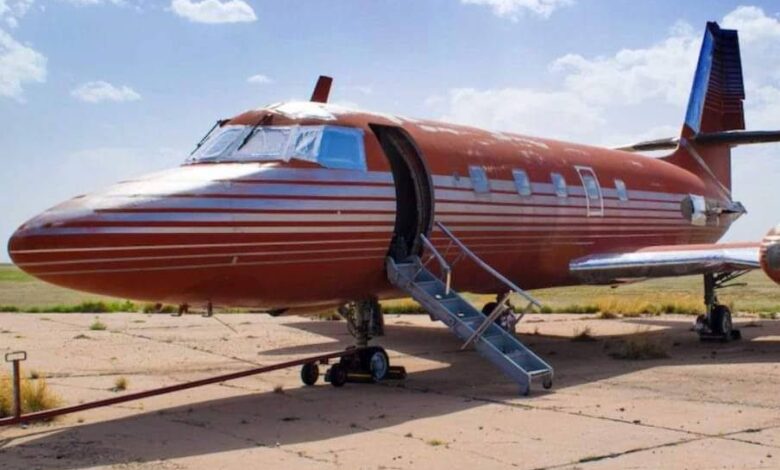
Elvis Presley was more than a music legend. He wasn’t just the swiveling hips, the unforgettable voice, or the man behind the most iconic songs of the twentieth century. Elvis was a cultural force, and his influence seeped into nearly every aspect of American life—from the way people dressed, to what they ate, to how they dreamed of living large. While fans remember the blue suede shoes, the glitzy jumpsuits, and even the quirky peanut butter, bacon, and banana sandwiches he adored, few realize that Elvis also had a knack for design. One of the most striking testaments to his eye for style and love of extravagance was his personal airplane.
In 1962, at the height of his fame, Elvis purchased a Lockheed JetStar and immediately had it customized down to the smallest detail. This wasn’t just a machine meant to ferry him from one concert to another. It was a flying palace—an extension of his personality and a reflection of the larger-than-life image he cultivated.
Step inside, and it’s easy to imagine the King himself stretched across a velvet seat, laughing with friends, or humming a tune before stepping onto a stage. The cabin was fitted with rich red velvet chairs, hardwood paneling, and plush carpeting. It was decadent without apology, a traveling lounge designed to make passengers feel like royalty. Elvis never did anything halfway, and his jet was no exception.
For years after his death in 1977, the aircraft stood still, parked in Roswell, New Mexico. It became something of a roadside shrine. Fans traveling through the desert would stop just to glimpse the jet that had once carried Elvis and his father, Vernon Presley, across the skies. The faded red paint and aging exterior didn’t diminish its allure. Instead, it became part of the mystique—a relic of a life lived in the fast lane, now sitting quietly under the New Mexico sun.
Recently, after more than four decades of gathering dust, the famous jet was auctioned at the Mecum Kissimmee Collector Vehicle Auction in Florida. It sold to an anonymous bidder—reportedly a passionate Elvis enthusiast—for $260,000. For the new owner, it wasn’t just about buying a plane. It was about acquiring a piece of history that symbolizes the excess, charm, and timeless appeal of the man who reshaped popular culture.
The real magic of the JetStar lies in its interior, which, even after years of neglect, still carries the essence of its famous owner. The cabin reveals Elvis’s vision of travel: one large, comfortable space designed for conversation and camaraderie. Passengers would have been greeted by crimson velvet seats, each one thickly cushioned, arranged to create a social atmosphere. The wood-paneled walls brought warmth, while a cutting-edge television (for the early 1960s) made the jet feel like a private living room in the sky.
Behind the lounge, a compact galley provided everything needed to prepare snacks and light meals. It’s easy to picture Elvis himself, late at night between tour stops, strolling back to whip up one of his favorite sandwiches. Imagine the King of Rock ‘n’ Roll, still in stage clothes, sliding bacon onto bread and smiling as he relaxed mid-flight. Even the small microwave in the galley, now a nostalgic relic, feels like a window into the everyday habits of a superstar.
The bathroom, too, was pure indulgence. Larger and more elegant than what you’d expect on most private jets, it was trimmed with velvet details and fitted with a sink far more stylish than the utilitarian fixtures modern travelers are used to. In typical Elvis fashion, even the smallest corner of the plane carried a sense of drama and comfort.
What makes the jet so captivating today isn’t just its design but what it represents. To walk inside is to step into Elvis’s world. The velvet seats and polished wood aren’t just decorations; they’re artifacts of a man who lived extravagantly but also personally—someone who cared enough about comfort and style to carry them into the skies.
Though its exterior has faded and its engines no longer roar, the plane remains in remarkable condition considering its decades parked in the desert. Its survival is a testament to the craftsmanship of its time and to the care it received during its years of service.
Now, with its new owner, the plane begins another chapter. Whether it ends up displayed in a museum, preserved as a collector’s treasure, or perhaps even restored to its former flying glory, one thing is certain: this JetStar is more than an old aircraft. It’s a time capsule from one of the most influential entertainers the world has ever known.
Elvis Presley’s abandoned plane isn’t just a story about aviation or celebrity memorabilia. It’s about legacy. For $260,000, someone didn’t just buy a jet—they bought a piece of rock ‘n’ roll history, a tangible reminder of how Elvis Presley continues to fascinate and inspire, decades after his final bow.
Even now, as fans watch videos of the interior, they can picture Elvis himself inside—laughing, singing, living larger than life. The King may have left the stage long ago, but in relics like this jet, his presence endures, timeless as ever.